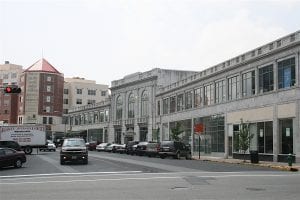
Smart growth in Montclair, N.J., turned an old post office into ground-level and second level retail space.
It’s an old joke, but in the development sense, the term “smart growth” is an oxymoron in many cases. There’s a reason we celebrate things like adaptive reuse, transit villages, and redevelopment: because it’s not sprawl growing away from the urban centers on former sod farms that Junior sold to Hovnanian when Pop retired. That said, there is plenty of dumb growth happening in up-and-coming cities to overshadow even the best development. And while in-town development is key in congested places like New Jersey, there is plenty of in-town dumb growth that is just as damaging to a downtown as good planning is a benefit. Check out this strip in one of three downtown areas in New Brunswick, N.J., home to Rutgers University and the world headquarters of Johnson & Johnson.
This, until recently, was one of Rutgers’ maintenance facilities. Now, you might ask “Is that a Rutgers maintenance facility where a storefront could be?” Good question! My answer: “Yes, Virginia, that’s ‘dumb growth.’ RU put that there because it was close to campus, they owned the land, and they didn’t care about the vitality of that strip.” Further, an ambivalent city government that gives carte blanche to its in-town institutions, likely provided no resistance to installing that thing. A happy update: that facility has been demolished, clearing that way for a new Rutgers bookstore. Who knows how the strip, nearby retailers, and the surrounding areas would have benefited had that been done 30 years ago? Now check out Montclair, N.J., a semi-urban township on the commuter rail line linking North Jersey to New York City, in the little photo at the top of this post. A redevelopment project there, completed in 2007, took an old, beautiful post office and turned it into ground-level and second level retail space, completely giving life back to what had ostensibly been an access road. Behind that building, you can see, is a new mixed-use residential building. Now, there are legitimate concerns with urban revitalization and transit oriented development, as David Holtzman, a West Virginia-based planner and writer says in his blog post Transit-Oriented, But Affordable?
Towns must create affordable units in redevelopment by providing incentives for the developer. They must, otherwise you perpetuate reverse White Flight, “golden ghettos,” or any other kind of exclusive setting. Further, in New Jersey, where property taxes fuel schools and government, there is a 4 percent cap on annual tax levy increases, so many in the planning field are acutely aware of redevelopment potentially increasing the number of school-aged children, and subsequent increases in school funding. On June 5, New Jersey Future, a research and policy not-for-profit hosted its Smart Growth Awards in Newark. The annual awards started in 2002 and “recognize individuals, businesses or organizations with the vision to approve or build projects that resist status-quo growth patterns and encourage smart-growth values and designs, while protecting open space, farmland, and environmentally sensitive areas. Projects are also recognized for their respect for community character, design, and historic features. In these times of dumb growth in urban areas, aesthetically speaking, nothing could be more important. Past winners have included government officials, developers, contractors, architects, planners, corporations, lenders and community groups. In his introductory remarks, New Jersey Future Executive Director Peter Kasabach pointed to some general criteria developers and municipalities should consider, including projects that are environmentally beneficial, and less driver-oriented, leading to all of the potential subsequent benefits outlined above. NJF has also pushed forth its Smart Housing Zones initiative that gives towns financial incentives to create walkable downtowns, as well as a mix of housing. The New Jersey State Legislature is expected to examine the Zones initiative this fall. The NJF event is annual, but it’s important to honor smart-growth planning and design on a daily basis. In areas that have been developed wisely, like Montclair’s addition to its town center, it’s easy to celebrate the benefits. In places like New Brunswick, it needs to be encouraged. There are a million New Brunswicks and Montclairs all throughout the country, and the economic and quality-of-life products resulting from good growth could influence the next town, and so on. Incidentally, New Brunswick is one of the Smart Growth awardees. A new hotel, right downtown, is winning for “mixed use downtown anchor.” It’s a successful model of how public and private resources can help mold a city’s renaissance.





Comments